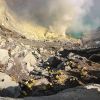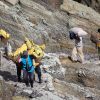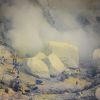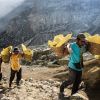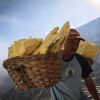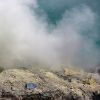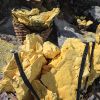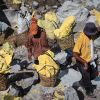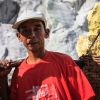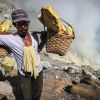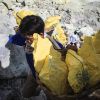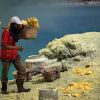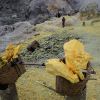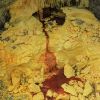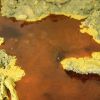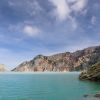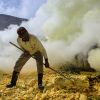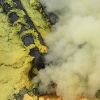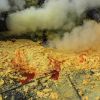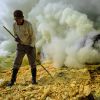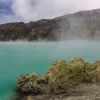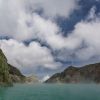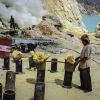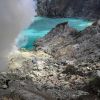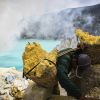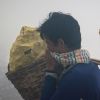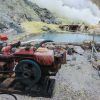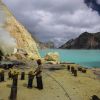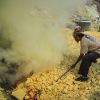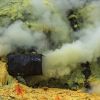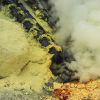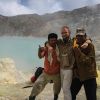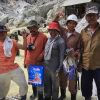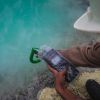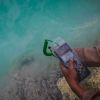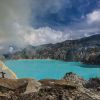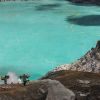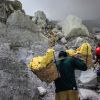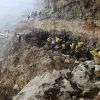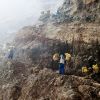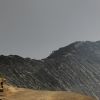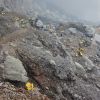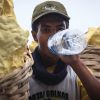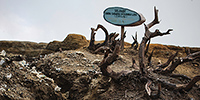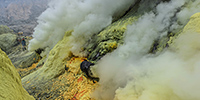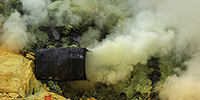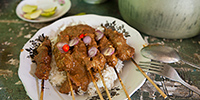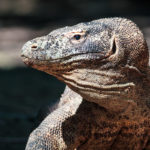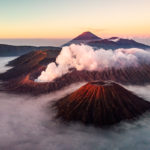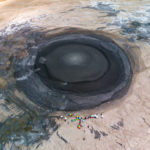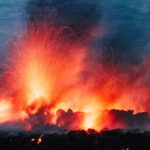The yellow Hell of the Ijen and the Soldiers of Sulphur
For many people coming to terms with a globalized everyday life became quite an essential daily task. In the East of the Indonesian island of Java, at the Ijen volcano (Kawah Ijen) to be more precise, courageous men are ruining their health day by day. To make their living, everyone literally transforms into a hell of a guy, when wresting sulphur, the yellow gold, from the fumaroles in a height of 2400 meters. And also for me visiting the Kawah Ijen and its acid lake should mean a test of mettle.
Shortly after sunrise the road leading from Banyuwangito Kawah Ijen is crowded with hundreds of coffee pickers being on their way to work. The volcanic soil in that region is providing perfect conditions for growing both coffee types, Arabica as well as Robusta. A few meters further up and shortly before the sheer crater rocks start to dominate the scenery, some other men are starting to work as well. They do it the same way like coffee pickers and take advantage of the early morning, as the midday heat is then still far away. They put on their shoes, drink a Kopi (coffee), grab for a cloth or perforated gas mask and make their way to the volcano.
Overnight the sulphur-saturated vapours of the Ijen volcano “restored” the original condition of the crater bottom near the fumaroles and the area at the feet of the steam leading metal pipes is homogeneously covered with yellow again. “That’s what we’ll mine now”, says Mohamed, having a certain experienced undertone in his voice. The small, about 1.64 meters tall man is the supervisor, whereas the word supervisor sounds like labour protection, shutoffs and good working conditions. At the Kawah Ijen it just means that somebody is a bit more in charge than others. “Ten days a month we are working down here. The rest of the month we spend with our families. Personally I am living with my wife and five children in Banyuwangi“, explains Mohamed in more or less fluent English.
From the visitor’s entrance to the crater it is another 3 kilometer walk to the volcano’s summit and after having reached the crater region, you also covered difference of 500 meters in altitude. Along that way you also pass the shelter where the workers are staying overnight and where the sulphur loads get weighted and paid off. The scenery around the crater looks spooky. Imagine to stand on the edge of a huge, more than 1 kilometre wide and heavily eroded caldera, whose upper slopes are literally free of life as everything died from volcani gas exhalations. The gas leaking from the vents at the crater bottom is a hair-raising stink; you can already smell it when standing on the crater rim only, the so called Ijen plateau and when looking through the smoke screen you can already spot small yellow moving spots deep down in the volcano – the workers.
The crater and whole surrounding scenery looks as if you would stand on the rim of a giant cooling tower; and tons of dense sulphur steam emphasise that impression. In the southeast of the caldera giant fumaroles are emerging and rising up to sky; fumaroles being that strongly saturated with sulphur that when being cooled down the sulphur is made sublimating out. Red like blood the chemical element named “S” is creeping out of the barrels that are mounted at the end of the cooling pipes. It doesn’t take much time until it turns yellow and becomes as hard as stone. On very productive days those sulphur beds can be up to 8 meters thick in the morning, but usually it’s a around meter only.
Ijen’s crater bowl is the home of a magically shimmering turquoise lake being 1km long and up to 200 meters deep. A pH-value of less than 0.3 makes it one of the most acidic volcanic waters in the world. Easily the acid absorbs the egg that I have taken with me from Banyuwangi just for the purpose of showing the acid’s power. While standing at the lake’s bank, Mohamed disappears in the tent calling “Wait Mister Flo, I have thermometer!” After rummaging around he comes back and holds the temperature sensor into the lake. 40°C, 80°C, 120°C – when the thermometer stopped at more than 200°C, my brows started to knit and I don’t really want to know how surprised I was looking… However, soon it turned out that the temperature sensor saw the acid lake a few times too often as the actual average temperature of the lake is about 40 degrees. Several feeding rivers mouthing into the lake are much hotter though; they’re literally boiling. One thing is clear: the Ijen is only sleeping and he’s keeping an eye open while doing that…
Being back on the mining plateau the wind suddenly shifts and pushes the dense steam into the crater. My hands automatically take the gas mask and push it in my face with might and main. I am breathing voraciously, but even the air filtered by the mask is beyond all bearing; it feels like your lungs are burning. Not to mention the pain in the eyes and nose. My blood curdles when throwing a glance at what is happening around me. One of Mohamed’s workers passed out and faded away in the sulphur steam. Meanwhile the steam is that dense that you literally cannot see your hand in front of your face; visibility is less than 10-20cm. All that happened within a few seconds only.
Being completely surrounded by dense sulphur fumes and standing not far away from an acid lake, orientation and the feeling where is left and right, where is up and down becomes pretty essential. I hunkered down and tied the gas mask belt that tight that it literally cut into my face skin. There are only a few moments in life when the human’s dependency on technics, in my case the dependency on the mask’s thin plastic layer, becomes that apparent. In small steps I was guessing my way through the yellow fog and suddenly touched the worker’s pants. It wasn’t pretty difficult to take the small light-weighted man on my shoulders and like an insect I duck-walked into the light, towards the bright side of life. Fortunately meanwhile the sulphur fumes allowed to identify from what side the sunlight is coming from. Immediately all other men flocked to us and, blessing in disguise, the bloke’s vital function didn’t take a back seat. To my utter dismay he walked directly back to work after waking up from this severe black out………
“Don’t say, up, back!”, followed by “Lose job…” were the first tremulous word snippets coming over Mohamed’s lips. At the latest when sharing my rations and having a luxurious apple feast it was clear, that my lips will be sealed and all things happened will remain in the crater. The 11a.m. landmark was already in sight and it was time to go either way. To boot there were more and more tourists daring to climb down to the crater bottom wearing flip-flops and a pulp facemask only. A Frenchman hit the bulls-eye when gasping for air and saying: “The smoke is killing me!”
Mohamed insisted on helping me to carry the photo equipment back to the crater rim. The small brown eyes were quite surprised when realizing that he just made a promise to carry 20 kilogram on his back all the time :-) Well, that is not a real competition to the usual 70-80kg heavy sulphur load that the workers are carrying on their shoulders over the crater rim. Their tread-less rubber boots aren’t a big help when climbing in a steep and rugged rock wall, as only one little mistake can be enough and you plus all the people behind you get a serious problem. For a last time the wind came back and pushed the sulphur fumes against the crater wall, instantly making the soldiers of sulphur loudly moan. A spooky scenery. However that comes as no surprise, as many of the workers have only a cloth to “protect” their mouth and nose from the fumes. Most of the cloths are coarsely meshed, would be a better fishing net than an inhalation protection.
Having reached the crater rim the tourists were pretty surprised when we climbed out of the volcano like brothers arm in arm, giggling and speaking about God and the world, his wife, his kids, to boot all that in a pretty broken English-Indonesian language mixture. Together with the last porters we were ascending down to the valley. At the shelter they get the money for their cargo, which is 600 rupees per kilogram at the moment. That is 4 Euro-Cent, making a 70kg sulphur load being about 2,80 Euros worth. Not much cash for an exertion whose final stage is for example a carelessly inflamed matchstick. But that’s only one field of sulphur application. For Mohamed the way of the yellow gold ends in Surabaya, when the ships are carrying the sulphur away. The Ijen adventure comes to an end.
After local volcanologist Heri marvelled at my pictures of the erupting Yasur volcano, it was already time to say goodbye. But I didn’t go without giving Mohamed a better gas mask, my gas mask. I didn’t need it anymore… A job that actually means dying by degrees is never done voluntary by anybody. But unlike slaves the boys are identifying themselves with their profession. They know that they are little heroes and that’s why they’re posing whenever a camera comes into reach. Hence generally seen the word choice of many reports does not fit, when the workers become titled again as “slaves”.
However, sometimes Ijen’s crater rim can be quite a playground for tourists. At peak time you can even meet up to 200 people looking down into the crater. Beside flip-flops and insufficient breathing protection (face mask), also crazy people taking a newborn baby on the volcano can be seen……………
The Ijen and its workers are a favoured photo motif. Though, most of the pictures doing the rounds are posed; not a few workers are getting money or cigarettes for that. Often they also try to sell cones of solified sulphur, or figures cast in yellow gold. Caution: only a few airlines are accepting sulphur in your normal baggage and literally never in hand luggage. The big airlines don’t belong to them. To boot that stuff evaporates incredibly, making your baggage stink as hell, literally… :-)
